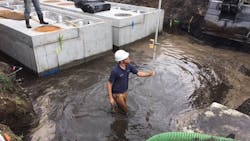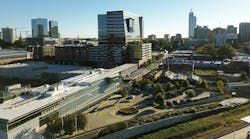Versatile Biofiltration System Meets Bayside Site Constraints
Introduction
Originally built in the 1920s and once home to the famous Tourister Luggage Co., Tourister Mill is now a stunning waterfront apartment community, on the beautiful bay of Warren, R.I. As part of the new renovation, the developer, Brady Sullivan Properties, had to redesign surrounding parking lots and roadways while creatively addressing unique construction and design challenges.
Given the development’s location directly along the bay, it was imperative to comply with the Rhode Island state storm water quality permits closely and manage land use in order to maximize the limited open space for occupant amenities and parking.
The Situation
The Rhode Island Department of Environmental Management (DEM) serves as the chief steward of the state’s natural resources – from beautiful Narragansett Bay to our local waters and green spaces to the air we breathe. Their mission is to protect, restore, and promote our environment to ensure Rhode Island remains a wonderful place to live, visit and raise a family.
In order to comply with Rhode Island regulations, the developers of Tourister Mill Apartments were required to implement Low Impact Development (LID) storm water treatment systems to mitigate the hazardous pollutants generated from their impervious areas. Pollutants related to this property’s use could include:
• Nutrients and bacteria;
• Sediments, trash and debris; and
• Oils and grease
The Challenge
In the original parking lot design, 18 bulky storm water systems with low-efficiency standards, were specified to provide the necessary pollutant removal, but with those units, the development would have lost 34 parking spaces.
After consulting Shane Murphy, a local storm water expert with Bio Clean Environmental, engineers found a redesign option using only five MWS Linear biofiltration systems.
The Solution
The MWS Linear utilizes horizontal flow, a design that allows the system to yield a higher treatment capacity in a smaller footprint than competitor systems. Additionally, the MWS Linear can incorporate an open planter bed that allows it to blend into surrounding landscapes. These advantages gave the five MWS Linear systems the ability to adapt and fit without losing a single parking space.
An elevated water table also posed a serious challenge. Any non-proprietary bioretention system would never be feasible, as tidal changes would overwhelm and wash out the system, while bulkier systems would require deeper excavation and unrestrained construction costs. The MWS Linear, however, is a precast concrete vault, completely enclosing multiple treatment stages: pretreatment, biofiltration, and discharge – saving land and long-term maintenance costs. Lastly, the horizontal flow design maximizes surface area by circulating storm water flow around the Wetland Media chamber. This gives the MWS Linear the ability to provide treatment in far less space.


